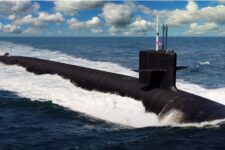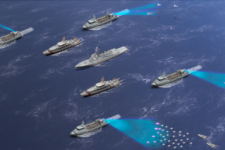
NATIONAL HARBOR, MD: “The LCS is a warship and it is fully capable of going into combat situations,” Navy Secretary Ray Mabus insisted to skeptical reporters yesterday. Mabus was attempting to take the edge off last week’s frank acknowledgment by the Chief of Naval Operations, Adm. Jonathan Greenert, that the Littoral Combat Ship is significantly less survivable than mainline Navy vessels.
“One of the things the CNO said the other day is one of the things the LCS can do is help prevent warfare,” Mabus said – by doing the day-to-day work of maritime policing and partnership building in accordance with the new global strategy, for example. But, he went on, “if there is a war, we aren’t going to have the LCS out there by itself.” Other, more robust vessels can provide cover against enemy warships, cruise missiles, and aircraft while the LCS conducts its specialized shallow-water missions sweeping mines, hunting submarines, or fending off swarms of small boats.
Mabus had just come from a speech to the Navy League’s Sea-Air-Space convention that touted bringing down costs on LCS as one of the Navy’s successes. After shocking cost overruns on the first two ships – caused largely by a redesign done mid-way through construction, precisely to make them more survivable in combat – the cost per ship has dropped below $400 million. Today, Mabus boasted in his remarks, “they’re being built under fixed-price contracts.”
The Navy needs to keep LCS costs under control because its plans to buy 55 of them are critical to keeping the size of the fleet around 300, a target Mabus hopes to hit in 2019. Even at the overrun price tag of over $600 million apiece, the Littoral Combat Ships were still far more affordable than the $1.7 billion DDG-51 Aegis destroyers that are currently the fleet’s most numerous surface combatant. And while LCS may not be as battle-worthy as a larger and more expensive destroyer, Mabus said, it can show the flag just as well. “Today we’re using DDG-51s which are multi-billion dollar warships, we’re using amphibs [amphibious warfare ships] which are multi-billion dollar warships to do some of these engagement activities that LCS could do,” Mabus told reporters. “We’re going to use LCS to free up some multi-mission ships.”
The problem with scattering Littoral Combat Ships around the planet is that threats are proliferating globally as well. In 2006, the Lebanese group Hezbollah crippled an Israeli corvette and sank a Cambodian merchant ship with shore-launched cruise missiles of Chinese manufacture, the kind of weapon once exclusively possessed by major nation-states but now increasingly available to non-state “hybrid” adversaries. Since having larger vessels escort Littoral Combat Ships everywhere defeats the point, sometimes the LCS is going to have to fend for itself, and skeptics argue it’s just not capable.
“When you come within 25 miles of an enemy shore nowadays, if there’s even an apartment house there, someone’s likely to shoot a missile out of the garage at you,” said Norman Polmar, a naval analyst and author who’s been an outspoken critic of the LCS. While the ship’s proponents tout its 40-knot speed, Polmar notes it’s hard to outrun a cruise missile, and he finds LCS lacking in other defenses against such a threat like electronic countermeasures and even simple chaff. If it is hit, he said, “this ship cannot take much damage”: Besides having a less robust structure than traditional warships, LCS has a much smaller crew – about 80 personnel counting “mission module” specialists compared to over 200 on the old Perry-class frigates – and “survivability is often dependent on having enough people to do damage control.”
“LCS is a capability that we need very badly,” Mabus insisted to reporters. “Very fast, very shallow draft, able to operate in littorals.” The question is whether it’s tough enough for the dangers lurking in the shallows.
Navy is down $1B in munitions from ops in Red Sea, says SECNAV
The dollar figure from the secretary comes as Speaker of the House Rep. Mike Johnson said he is ready to bring the supplemental funding bill the Navy needs passed to the floor for a vote.


























